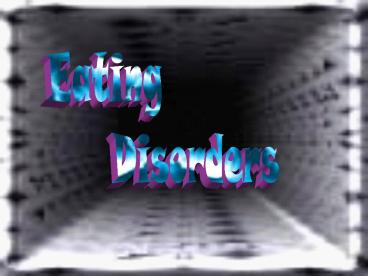Eating Disorders - PowerPoint PPT Presentation
1 / 16
Title:
Eating Disorders
Description:
Title: Eating Disorders Author: John P. Forsyth Last modified by: Warren Wilson College Created Date: 5/28/1995 4:16:46 PM Document presentation format – PowerPoint PPT presentation
Number of Views:372
Avg rating:3.0/5.0
Title: Eating Disorders
1
Eating Disorders
2
An Overview of Eating Disorders
- Two Main Types
- Anorexia Nervosa
- Bulimia Nervosa
- Share Strong Drive to be Thin
- Largely a Westernized, Female Problem
- Largely an Upper SES Problem
3
Assessment of Eating Disorders
- Interview
- Observation
- Reports from family/friends
- Objective Psychological Tests
- (e.g., Eating Disorder Inventory)
4
Bulimia Nervosa
- Bingeing
- Eat Large Amounts of Food
- Eating is Out of Control
- Compensatory Behaviors
- Purging via
- Self-Induced Vomiting, Enemas
- Laxatives, Diuretics, Exercise, Fasting
- Binge-Purge occur, on average, at least 2 X wk
for 3 months - Self-evaluation is unduly influenced by body
shape and weight
5
The Nature of Bulimia Nervosa
- Medical Consequences
- Salivary Gland Enlargement
- Eroded Dental Enamel
- Electrolyte Imbalance
- Intestinal Problems
- Calluses on Fingers and Hands
6
The Nature of Bulimia Nervosa
- Facts and Statistics
- 90-95 are Women
- Onset 16-19 Years of Age
- 6-8 of college women
- About 2.8 Population Overall
- Chronic if Left Untreated
7
The Nature of Anorexia Nervosa
- Clinical Description
- Intense fear of
- Gaining weight
- Becoming fat
- Refusal to maintain body weight
- 15 Below Expected Normal
- Distorted body image
- Amenorrhea (in females)
8
The Nature of Anorexia Nervosa
- Two Subtypes
- Restricting Type
- Excessive Dieting
- Binge-Eating / Purging Type
- Rely on Purging
- About Half of All Cases
9
The Nature of Anorexia Nervosa
- Medical Consequences
- Dry Skin, Brittle Hair or Nails
- Sensitivity to Cold (Lanugo)
- Risk of death (suicide, starvation, electrolyte
imbalance, heart problems)
10
The Nature of Anorexia Nervosa
- Associated Features and Facts
- Begins in adolescence (onset often associated
with a stressful life event) - Perfectionistic High-Achievers
- All-or-None Thinking
- Obsessive and Orderly
- Comorbid DSM Disorders
- Obsessive-Compulsive Disorder
- Substance Abuse
11
The Nature of Eating Disorders
- Causes
- Social and Cultural Factors
- - examples?
- Media
- Sets Impossible Idealized Images
12
The Nature of Eating Disorders
- Causes
- Biological Influences
- Runs in Families
- Unclear What is Inherited
- The Serotonin-Hypothesis BN represents an
underlying hyposerotonergic condition
13
The Nature of Eating Disorders
- Causes
- Dieting When food is restricted, we become
preoccupied with it! (The PsychoBiological
Impasse) - Family Influences (esp. in AN)
- Successful and Driven
- Concerned About Appearances
- Eager to Maintain Harmony
- Deny or Ignore Conflicts
- Lack of Open Communication
14
The Treatment of Eating Disorders
- Psychosocial Treatments for BN
- Cognitive-behavioral treatments
- Education about eating behavior
- Scheduled eating
- Exposure / Response prevention
15
The Treatment of Eating Disorders
- Psychosocial Treatments
- Anorexia Nervosa
- First restore normal weight!
- many will gain weight keeping the weight on
is harder - residential treatment
- control issues? IPT
16
The Treatment of Eating Disorders
- Biological treatments
- Bulimia Nervosa
- Because serotonin is thought to play an
important role in mediating satiety, SSRIs have
been tried - e.g., fluoxetine (Prozac) has demonstrated
effectiveness - Anorexia (not effective)































